2016 MERCEDES-BENZ GLA display
[x] Cancel search: displayPage 56 of 390
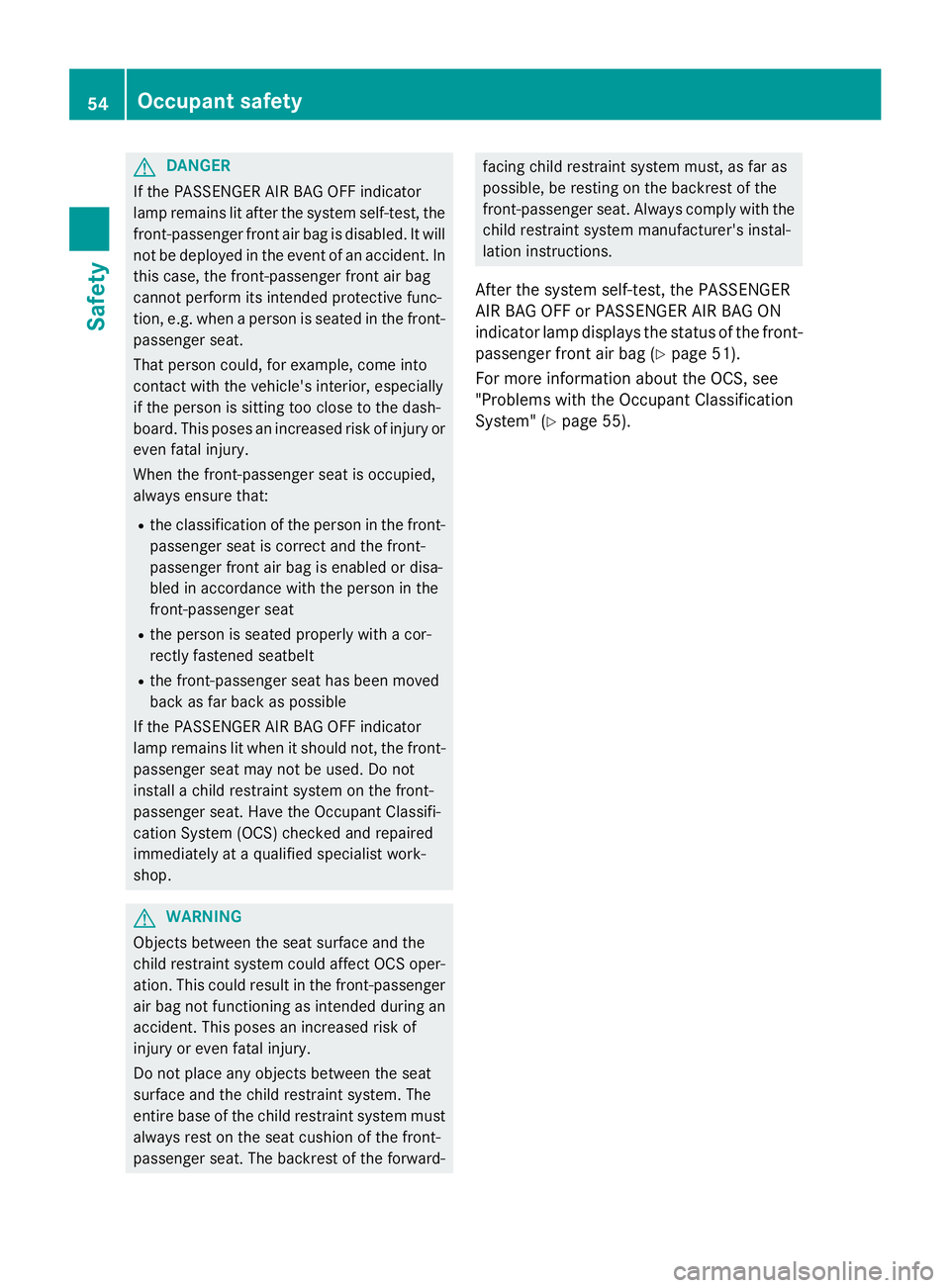
G DANGER
If th e PASSENGER AI R BA G OF F indicator
lamp remain s lit after th e system self-test , th e
front-passenger fron t air bag is disabled. It will
no t be deployed in th e event of an accident. In
this case, th e front-passenger fron t air bag
canno t perfor m it s intended protective func-
tion , e.g. when a person is seated in th e front-
passenger seat .
That person could, for example, come int o
contact wit h th e vehicle's interior, especially
if th e person is sitting to o close to th e dash -
board. This poses an increased ris k of injury or
eve n fatal injury.
Whe n th e front-passenger seat is occupied,
always ensur e that:R
th e classification of th e person in th e front-
passenger seat is correc t and th e front-
passenger fron t air bag is enabled or disa-
bled in accordanc e wit h th e person in th e
front-passenger seat R
th e person is seated properly wit h a cor-
rectl y fastene d seatbeltR
th e front-passenger seat has been moved
bac k as far bac k as possibl e
If th e PASSENGER AI R BA G OF F indicator
lamp remain s lit when it should not, th e front-
passenger seat may no t be used . Do no t
instal l a child restrain t system on th e front-
passenger seat . Hav
e th e O ccupant Classifi-
ca tion Syste m (OCS ) checke d and repaire d
immediately at a qualified specialist work-
shop.
G WARNIN G
Objects between th e seat surfac e and th e
child restrain t system could affec t OCS oper -
ation . This could result in th e front-passenger
air bag no t functioning as intended during an
accident. This poses an increased ris k of
injury or eve n fatal injury.
Do no t plac e any objects between th e seat
surfac e and th e child restrain t system. The
entire base of th e child restrain t system mus t
always res t on th e seat cushion of th e front-
passenger seat . The backrest of th e forward - facing child restrain t system must, as far as
possible, be resting on th e backrest of th e
front-passenger seat . Always compl y wit h th e
child restrain t system manufacturer' s instal -
lation instructions.
Afte r th e system self-test , th e PASSENGER
AI R BA G OF F or PASSENGER AI R BA G ON
indicator lamp displays th e status of th e front-
passenger fron t air bag ( Y
page 51) .
Fo r mor e information about th e OCS , see
"Problem s wit h th e Occupant Classification
System" ( Y
page 55) .54
Occupant safety
Safety
Page 67 of 390
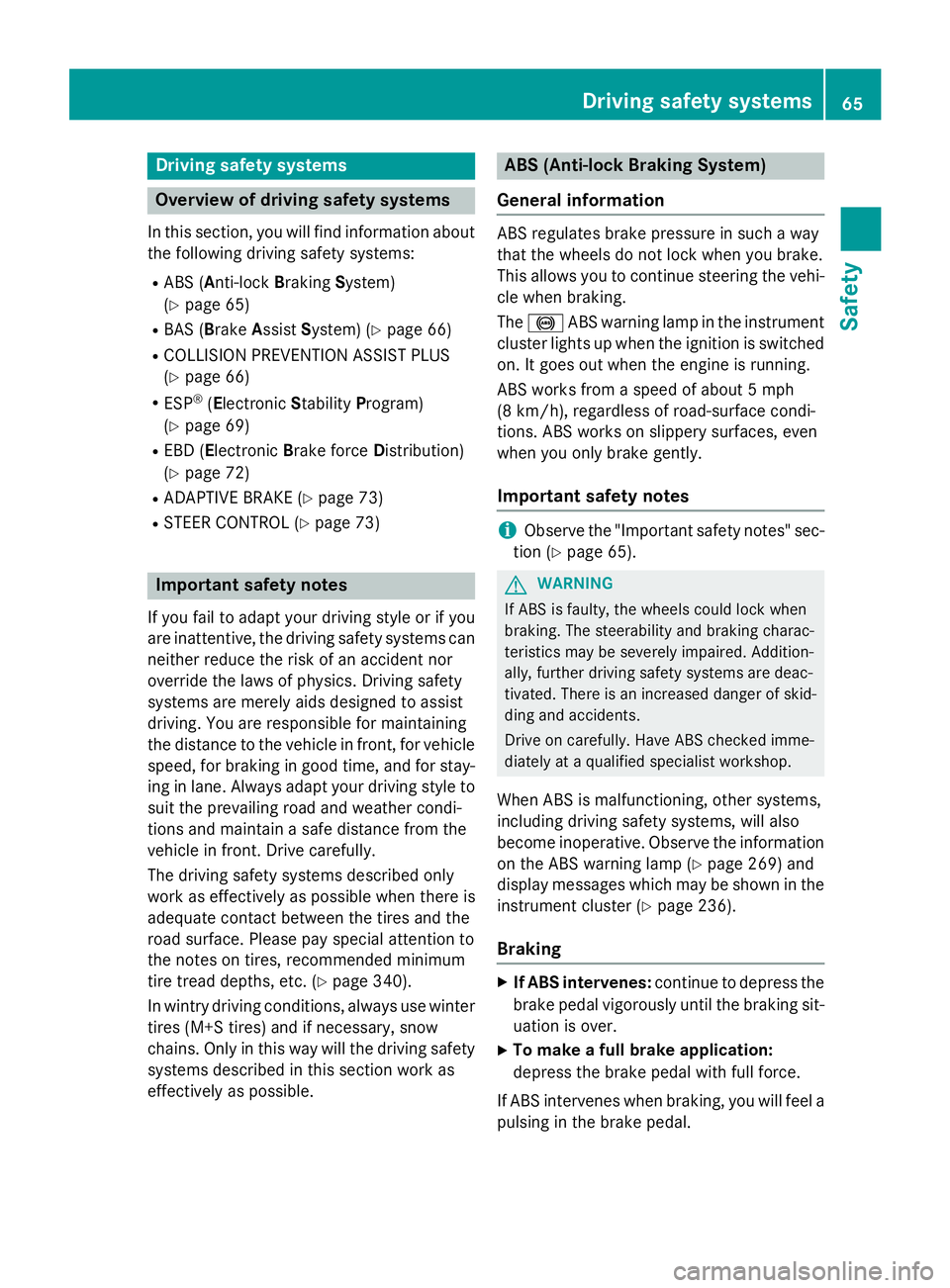
Drivin g safet y systems
Overview of drivin g safet y systemsIn this section , you will fin d information about
th e following drivin g safet y systems :R
AB S ( A nti-loc k B rakin g S ystem)
( Y
page 65) R
BA S ( B rake A ssist S ystem) ( Y
page 66 )R
COLLISION PREVENTION ASSIST PLU S
( Y
page 66 )R
ES P ®
( E lectronic S t ability P rogram)
( Y
page 69 )R
EB D ( E lectroni c B r ak e forc e D i stribution )
( Y
page 72) R
ADAPTIV E BRAKE ( Y
page 73 )R
STEE R CONTROL ( Y
page 73 )
Important safet y notesIf you fail to adapt your drivin g style or if you
are inattentive , th e drivin g safet y systems can
neither reduce th e ris k of an acciden t no r
override th e laws of physics. Driving safet y
systems are merely aids designed to assist
driving. You are responsible fo r maintainin g
th e distanc e to th e vehicle in front, fo r vehicle
speed, fo r braking in goo d time, and fo r stay-
in g in lane. Always adapt your drivin g style to
suit th e prevailin g road and weather condi-
tion s and maintain a saf e distanc e from th e
vehicle in front. Drive carefully.
The drivin g safet y systems described only
wor k as effectively as possible when there is
adequat e contact between th e tires and th e
road surface. Please pay special attention to
th e note s on tires , recommended minimum
tire tread depths, etc. ( Y
page 340).
In wintr y drivin g conditions, always use winte r
tires (M+ S tires ) and if necessary, snow
chains. Only in this way will th e drivin g safet y
systems described in this section wor k as
effectively as possible. ABS (Anti-lock Braking System)
General information AB S regulates brake pressure in suc h a way
that th e wheels do no t loc k when you brake .
Thi s allow s you to continue steerin g th e vehi-
cl e when braking .
The �% AB S warnin g lamp in th e instrumen t
cluster lights up when th e ignition is switched
on . It goe s out when th e engin e is running .
AB S works from a speed of about 5 mph
(8 km/h), regardles s of road-surfac e condi-
tions. AB S works on slipper y surfaces, eve n
when you only brake gently.
Important safet y notes
i Observ e th e "Important safet y notes" sec -
tion ( Y
page 65).
G WARNING
If AB S is faulty, th e wheels could loc k when
braking . The steerability and braking charac -
teristics may be severely impaired. Addition -
ally, further drivin g safet y systems are deac -
tivated. There is an increase d danger of skid-
din g and accidents .
Drive on carefully. Hav e AB S checke d imme-
diately at a qualified specialis t workshop .
Whe n AB S is malfunctioning, other systems ,
includin g drivin g safet y systems , will also
becom e inoperative . Observ e th e information
on th e AB S warnin g lamp ( Y
page 269) and
display message s whic h may be shown in th e
instrumen t cluster ( Y
page 236).
Braking X
If ABS intervenes: continue to depress th e
brake peda l vigorousl y until th e braking sit -
uation is over. X
To make a full brak e application:
depress th e brake peda l wit h full force.
If AB S intervenes when braking , you will feel a
pulsin g in th e brake pedal.Driving safety systems 65
Safety Z
Page 73 of 390
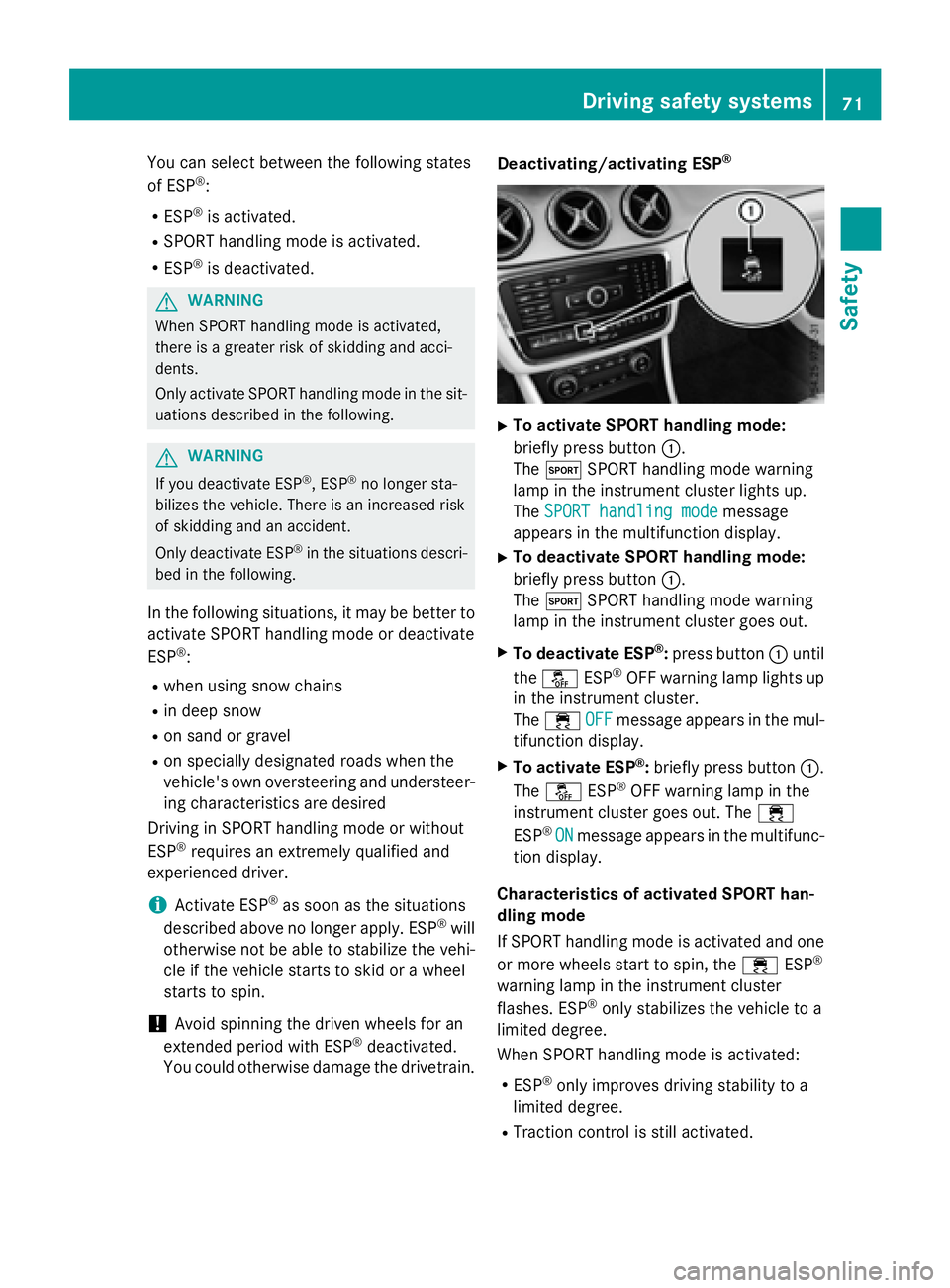
You can select between the following states
of ESP ®
:R
ESP ®
is activated.R
SPORT handling mode is activated. R
ESP ®
is deactivated.
G WARNING
When SPORT handling mode is activated,
there is a greater risk of skidding and acci-
dents.
Only activate SPORT handling mode in the sit-
uations described in the following.
G WARNING
If you deactivate ESP ®
, ESP ®
no longer sta-
bilizes the vehicle. There is an increased risk
of skidding and an accident.
Only deactivate ESP ®
in the situations descri-
bed in the following.
In the following situations, it may be better to
activate SPORT handling mode or deactivate
ESP ®
: R
when using snow chains R
in deep snow R
on sand or gravel R
on specially designated roads when the
vehicle's own oversteering and understeer-
ing characteristics are desired
Driving in SPORT handling mode or without
ESP ®
requires an extremely qualified and
experienced driver.
i Activate ESP ®
as soon as the situations
described above no longer apply. ESP ®
will
otherwise not be able to stabilize the vehi-
cle if the vehicle starts to skid or a wheel
starts to spin.
! Avoid spinning the driven wheels for an
extended period with ESP ®
deactivated.
You could otherwise damage the drivetrain. Deactivating/activating ESP ®
X
To activate SPORT handling mode:
briefly press button �C .
The �t SPORT handling mode warning
lamp in the instrument cluster lights up.
The SPORT handling mode message
appears in the multifunction display. X
To deactivate SPORT handling mode:
briefly press button �C .
The �t SPORT handling mode warning
lamp in the instrument cluster goes out. X
To deactivate ESP ®
: press button �C until
the �
Page 139 of 390
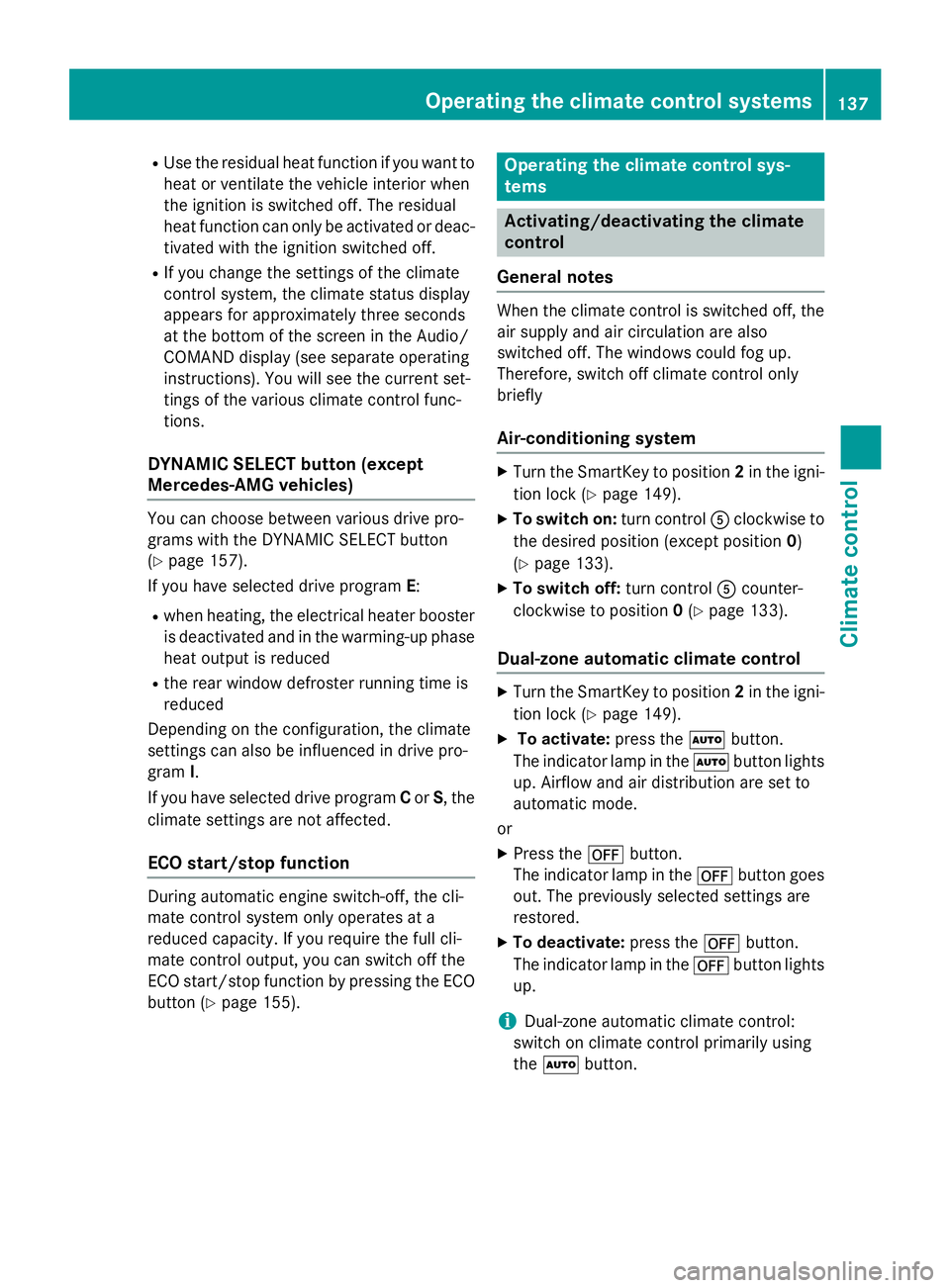
R
Use the residual heat function if you want to
heat or ventilate the vehicle interior when
the ignition is switched off. The residual
heat function can only be activated or deac-
tivated with the ignition switched off. R
If you change the settings of the climate
control system, the climate status display
appears for approximately three seconds
at the bottom of the screen in the Audio/
COMAND display (see separate operating
instructions). You will see the current set-
tings of the various climate control func-
tions.
DYNAMIC SELECT button (except
Mercedes-AMG vehicles) You can choose between various drive pro-
grams with the DYNAMIC SELECT button
( Y
page 157).
If you have selected drive program E :R
when heating, the electrical heater booster
is deactivated and in the warming-up phase
heat output is reduced R
the rear window defroster running time is
reduced
Depending on the configuration, the climate
settings can also be influenced in drive pro-
gram I .
If you have selected drive program C or S , the
climate settings are not affected.
ECO start/stop function
During automatic engine switch-off, the cli-
mate control system only operates at a
reduced capacity. If you require the full cli-
mate control output, you can switch off the
ECO start/stop function by pressing the ECO
button ( Y
page 155). Operating the climate control sys-
tems
Activating/deactivating the climate
control
General notes When the climate control is switched off, the
air supply and air circulation are also
switched off. The windows could fog up.
Therefore, switch off climate control only
briefly
Air-conditioning system X
Turn the SmartKey to position 2 in the igni-
tion lock ( Y
page 149). X
To switch on: turn control �
Page 153 of 390
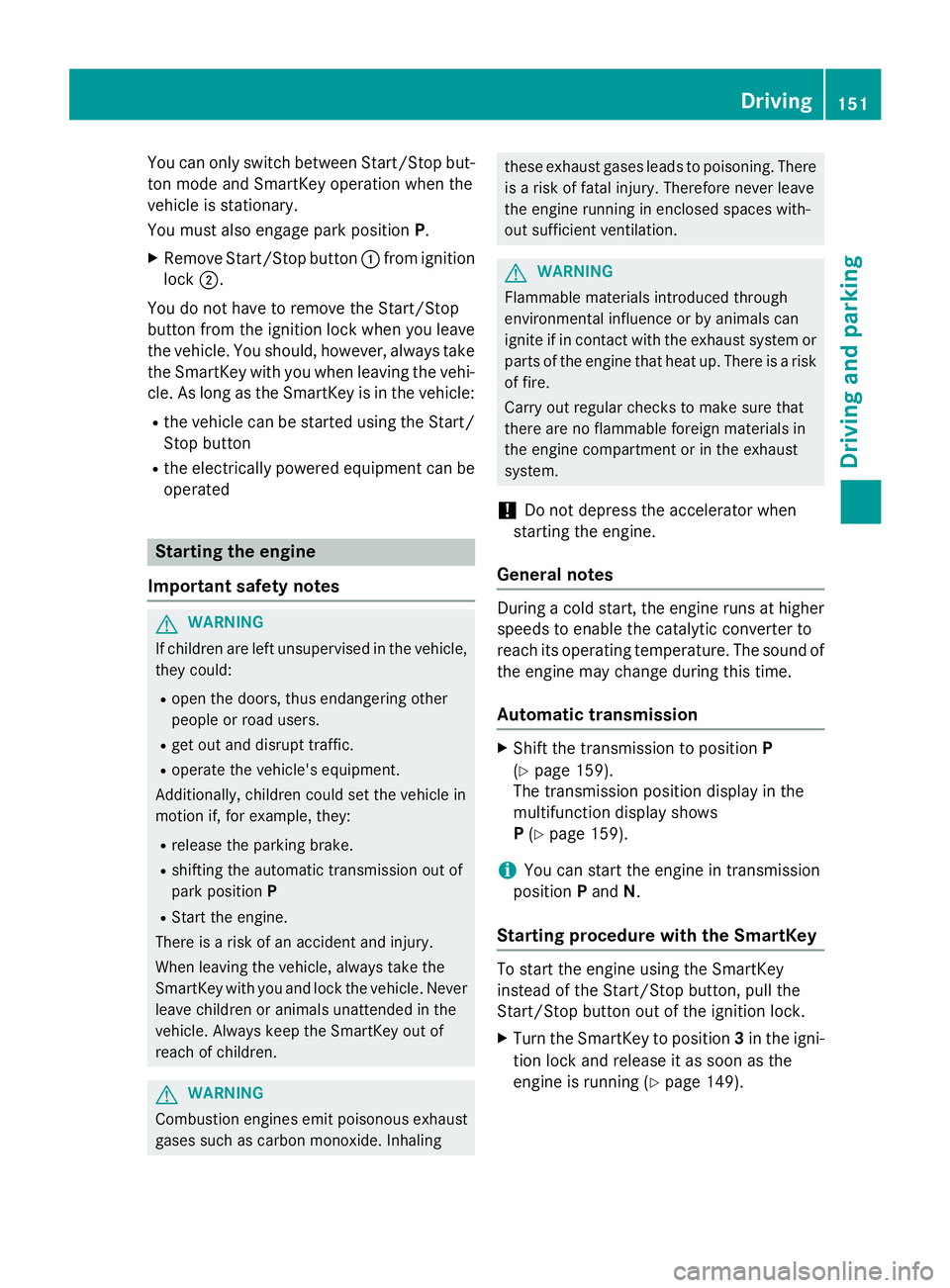
You can only switch between Start/Stop but-
ton mode and SmartKey operation when the
vehicle is stationary.
You must also engage park position P .X
Remove Start/Stop button �C from ignition
lock �D .
You do not have to remove the Start/Stop
button from the ignition lock when you leave
the vehicle. You should, however, always take
the SmartKey with you when leaving the vehi-
cle. As long as the SmartKey is in the vehicle: R
the vehicle can be started using the Start/
Stop button R
the electrically powered equipment can be
operated
Starting the engine
Important safety notes
G WARNING
If children are left unsupervised in the vehicle,
they could: R
open the doors, thus endangering other
people or road users. R
get out and disrupt traffic. R
operate the vehicle's equipment.
Additionally, children could set the vehicle in
motion if, for example, they: R
release the parking brake. R
shifting the automatic transmission out of
park position PR
Start the engine.
There is a risk of an accident and injury.
When leaving the vehicle, always take the
SmartKey with you and lock the vehicle. Never
leave children or animals unattended in the
vehicle. Always keep the SmartKey out of
reach of children.
G WARNING
Combustion engines emit poisonous exhaust
gases such as carbon monoxide. Inhaling these exhaust gases leads to poisoning. There
is a risk of fatal injury. Therefore never leave
the engine running in enclosed spaces with-
out sufficient ventilation.
G WARNING
Flammable materials introduced through
environmental influence or by animals can
ignite if in contact with the exhaust system or
parts of the engine that heat up. There is a risk
of fire.
Carry out regular checks to make sure that
there are no flammable foreign materials in
the engine compartment or in the exhaust
system.
! Do not depress the accelerator when
starting the engine.
General notes During a cold start, the engine runs at higher
speeds to enable the catalytic converter to
reach its operating temperature. The sound of
the engine may change during this time.
Automatic transmission X
Shift the transmission to position P
( Y
page 159).
The transmission position display in the
multifunction display shows
P ( Y
page 159).
i You can start the engine in transmission
position P and N .
Starting procedure with the SmartKey
To start the engine using the SmartKey
instead of the Start/Stop button, pull the
Start/Stop button out of the ignition lock. X
Turn the SmartKey to position 3 in the igni-
tion lock and release it as soon as the
engine is running ( Y
page 149).Driving 151
Driving and parking Z
Page 156 of 390
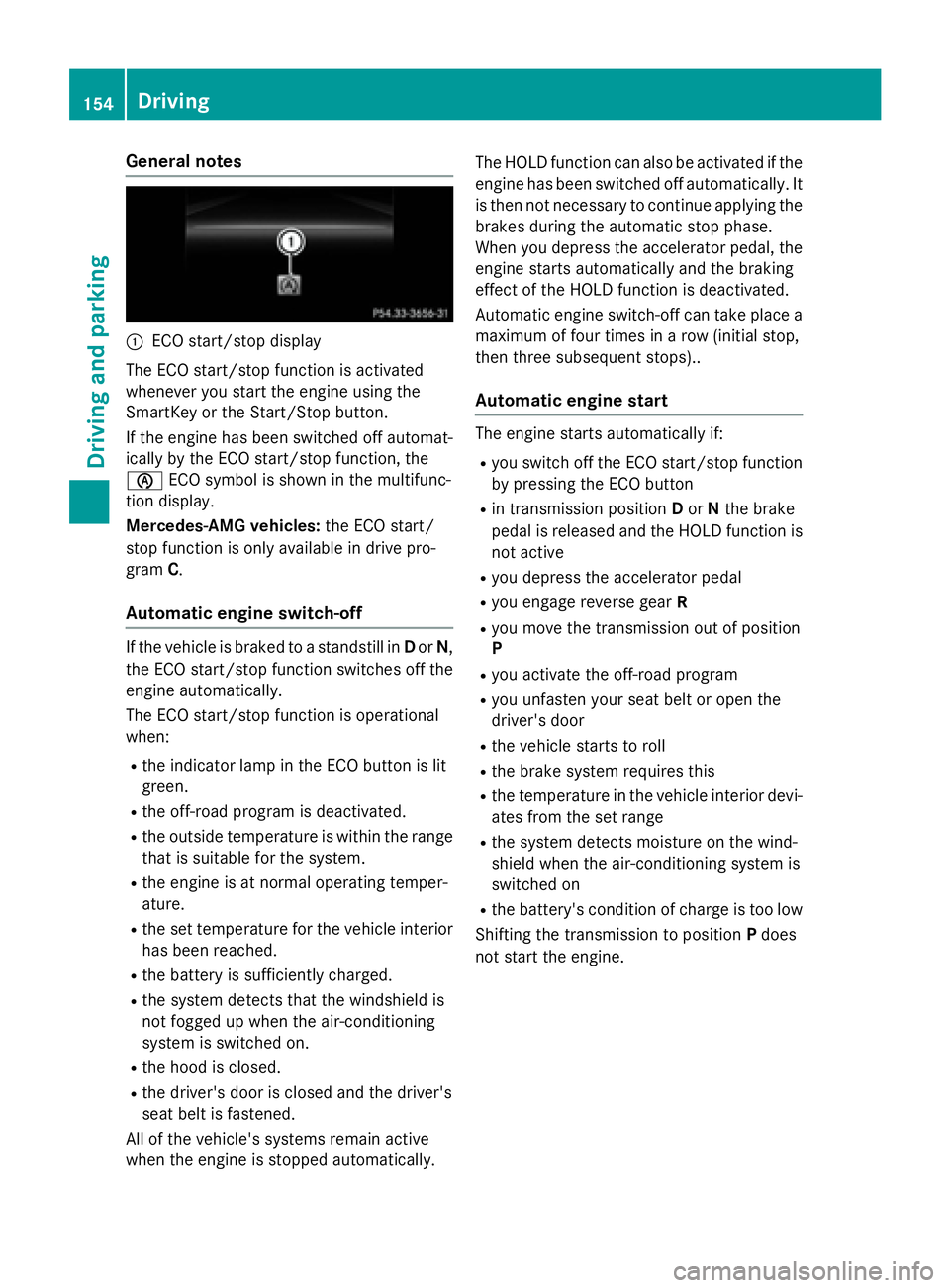
General notes
�C
ECO start/stop display
The ECO start/stop function is activated
whenever you start the engine using the
SmartKey or the Start/Stop button.
If the engine has been switched off automat-
ically by the ECO start/stop function, the
�
Page 159 of 390
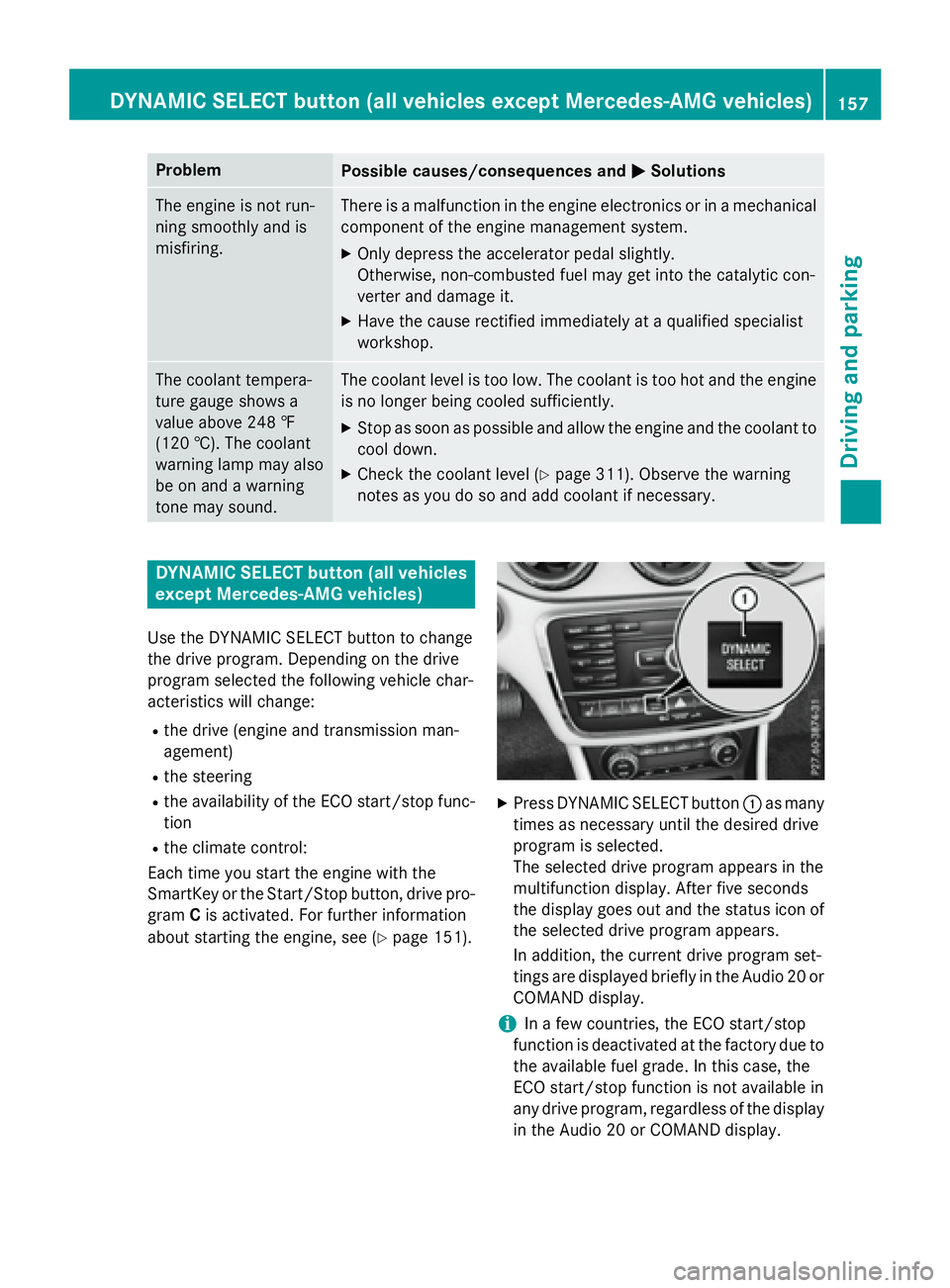
Problem
Possible causes/consequences and �P Solutions
The engine is not run-
ning smoothly and is
misfiring. There is a malfunction in the engine electronics or in a mechanical
component of the engine management system. X
Only depress the accelerator pedal slightly.
Otherwise, non-combusted fuel may get into the catalytic con-
verter and damage it. X
Have the cause rectified immediately at a qualified specialist
workshop.
The coolant tempera-
ture gauge shows a
value above 248 ‡
(120 †). The coolant
warning lamp may also
be on and a warning
tone may sound. The coolant level is too low. The coolant is too hot and the engine
is no longer being cooled sufficiently. X
Stop as soon as possible and allow the engine and the coolant to
cool down. X
Check the coolant level ( Y
page 311). Observe the warning
notes as you do so and add coolant if necessary.
DYNAMIC SELECT button (all vehicles
except Mercedes-AMG vehicles)
Use the DYNAMIC SELECT button to change
the drive program. Depending on the drive
program selected the following vehicle char-
acteristics will change: R
the drive (engine and transmission man-
agement) R
the steering R
the availability of the ECO start/stop func-
tion R
the climate control:
Each time you start the engine with the
SmartKey or the Start/Stop button, drive pro-
gram C is activated. For further information
about starting the engine, see ( Y
page 151). X
Press DYNAMIC SELECT button �C as many
times as necessary until the desired drive
program is selected.
The selected drive program appears in the
multifunction display. After five seconds
the display goes out and the status icon of
the selected drive program appears.
In addition, the current drive program set-
tings are displayed briefly in the Audio 20 or
COMAND display.
i In a few countries, the ECO start/stop
function is deactivated at the factory due to
the available fuel grade. In this case, the
ECO start/stop function is not available in
any drive program, regardless of the display
in the Audio 20 or COMAND display.DYNAMIC SELECT button (all vehicles except Mercedes-AMG vehicles) 157
Driving and parking Z
Page 160 of 390
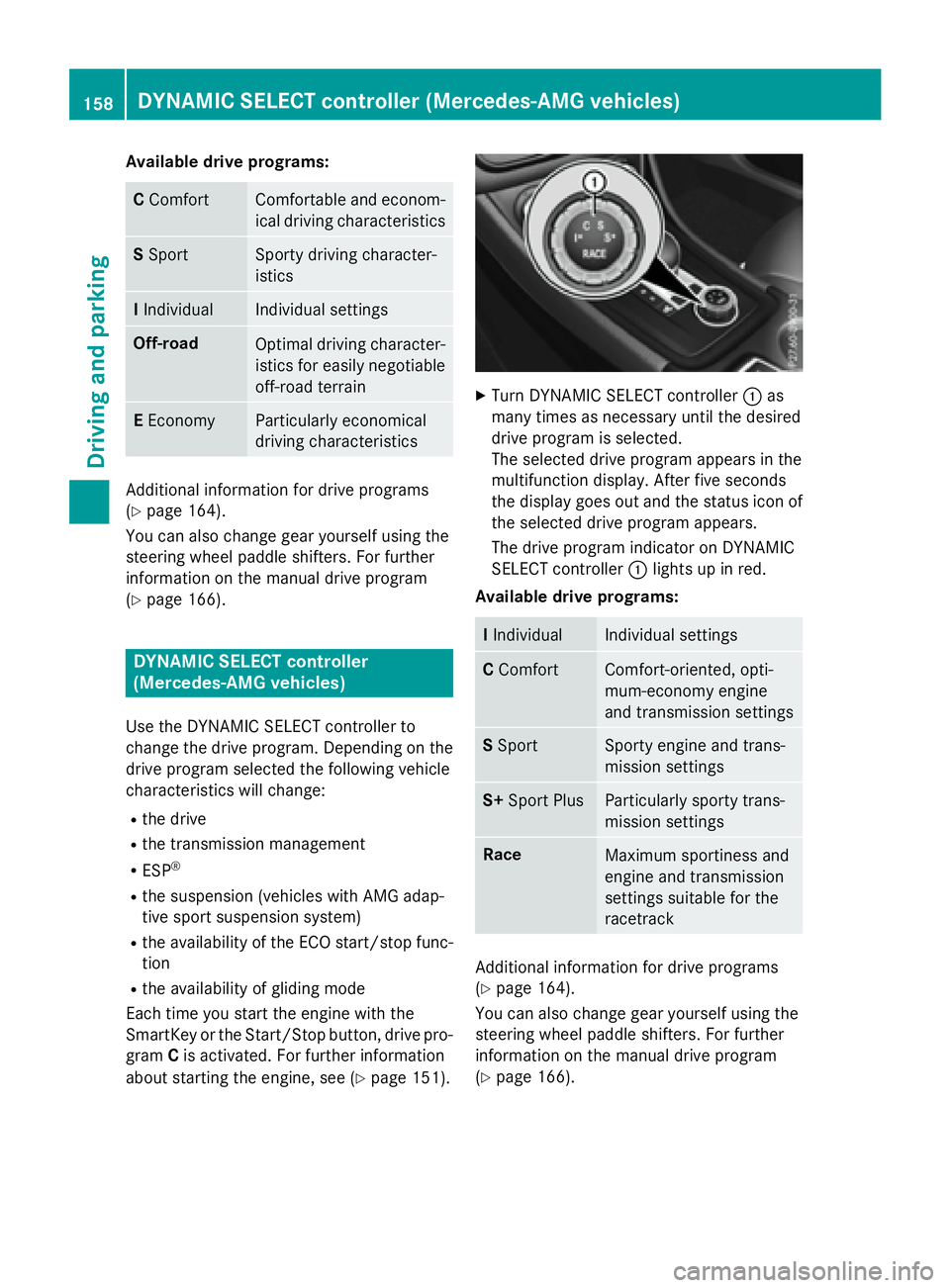
Available drive programs:
C Comfort Comfortable and econom-
ical driving characteristics
S Spo rt Sporty driving character-
istics
I Indivi dual In dividual settings
Off-road
Optimal driving character-
istics for easily negotiable
off-road terrain
E Economy Particularly economical
driving characteristics
Ad dit ional information for drive programs
( Y
page 164).
You can also change gear yourself using the
steering wheel paddle shifters. For further
information on the manual drive program
( Y
page 166).
DYNAMIC SELECT controller
(Mercedes-AMG vehicles)
Use the DYNAMIC SE LE CT controller to
change the driv e program. Depending on the
driv e program selected the following vehicle
characteristics will change: R
the driv eR
the transmission management R
ESP ®
R
the suspension (vehicles with AMG adap-
tive sport suspension system) R
the availab ilit y of the ECO start /s top func-
tion R
the availab ilit y of gliding mode
Each time you start the engine wit h the
Sm artKey or the St art /S top button, drive pro-
gram C is activated. For further information
about starting the engine, see ( Y
page 151). X
Turn DYNAMIC SE LE CT controller �C as
many times as necessary unt il the desired
driv e program is selected.
The selected driv e program appears in the
multifunction display. After five secon ds
the disp lay goes out and the status icon of
the selected drive program appears.
The driv e program indicator on DYNAMIC
SE LE CT controller �C lights up in red.
Available drive programs:
I Indivi dual Indivi dual settings
C Comfort Comfort-oriente d, opt i-
mum-economy engine
and transmission settings
S Spo rt Spo rty engine and trans-
mission settings
S+ Sport Plus Particularly sporty trans-
mission settings
Race
Maximum sportiness and
engine and transmission
settings suitable for the
racetrack
Additional information for drive programs
( Y
page 164).
You can also change gear yourself using the
steering wheel paddle shifters. For further
information on the manual drive program
( Y
page 166).158
DYNAMIC SELECT controller (Mercedes-AMG vehicles)
Driving and parking